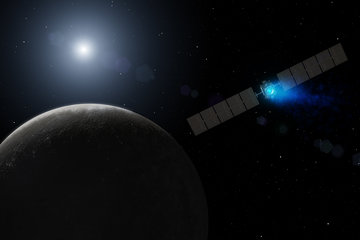Stars falling from the sky
In the coming nights, the Perseid meteors will streak across the skies
Under clear skies and from a dark vantage point, stargazers can anticipate a celestial spectacle on the nights of August 12-13, as the Perseid meteor shower makes its annual appearance. At its peak, under optimal conditions, you might see a meteor every two to three minutes. The Perseids, originating from the comet 109P/Swift-Tuttle, have been captivating observers for nearly two millennia, with the earliest recorded sightings dating back to ancient China.
Text: Helmut Hornung

The summer meteors that appear to radiate from the constellation Perseus are also known as Laurentius' tears - or the tears of St. Lawrence - named after the early Christian martyr who was tortured by fire on the orders of Roman Emperor Valerian on August 10, 258. According to legend, these shooting stars represent the fiery tears shed by the saint after his death.
But what is really behind the Perseids? Ancient Greek scholars once believed these meteors were caused by gases from dead plants or electrically charged air masses. It wasn’t until the 19th century that Italian astronomer Giovanni Schiaparelli, famed for his discovery of the water canals of Mars, identified the true cosmic origin of these meteors: they are linked to wandering celestial bodies. Our Earth races around the sun at nearly 110,000 kilometers per hour, faster than any jet plane. The sun’s gravity also holds comets in its grasp, celestial objects that typically reside in the outer reaches of the solar system. These comets consist of a deep-frozen core of ice and dust, spanning several kilometers. Occasionally, they venture into the inner solar system, where they develop spectacular tails of gas and dust.
A meteor flashes across the sky
As comets orbit the sun, they gradually lose material. The particles shed from the comet’s nucleus remain in nearly the same path, according to the laws of celestial mechanics. When Earth crosses a comet’s orbit, it encounters a barrage of these particles. If a meteoroid enters Earth’s atmosphere at speeds of up to 260,000 kilometers per hour, the friction with air particles generates a plasma channel where atomic processes occur, causing a meteor to flash, typically at an altitude of around 80 kilometers. Not all traces of light that can be seen in the sky come from comets. Some meteoroids are ejected from asteroids, which also orbit the sun If a larger chunk survives its intense passage through the atmosphere and reaches the ground, it is called a meteorite.
The original comet of the Perseids is 109P/Swift-Tuttle. One of its two discoverers was Lewis Swift, the son of a farmer from New York. An injury at the age of 13 prevented Swift from helping on his parents' farm, so he turned to reading and observing the sky, particularly in the field of astronomy. On 16 July 1862, Swift discovered his first comet. Three days later and independently of him, the astronomer Horace Parnell Tuttle at the American Harvard Observatory also spotted the pale speck of light.
Swift-Tuttle later developed into a magnificent object, with a tail that shimmered across a length equivalent to 60 full moon diameters in the sky. From the orbital data, researchers calculated its orbital period to be 120 years and predicted its next rendezvous with Earth in 1981. However, Swift-Tuttle did not show up as expected. It wasn't until September 26, 1992, that a Japanese amateur astronomer rediscovered the comet. Today, scientists believe it has an orbital period of 133 years. Despite its delayed return, Swift-Tuttle has left a lasting mark on our skies for at least 2,000 years: every mid-August, it sends cosmic greetings to Earth in the form of the Perseids.

The meteors of the Perseids all seem to originate from a specific point in the sky, similar to how snowflakes seem to converge on a car windshield during a drive through a thick snowstorm. This point is called a radiant, and its position within a constellation gives the meteor shower its name. Throughout the year, more than a dozen prominent meteor showers occur.
The first Perseids typically appear at the end of July, reaching their peak on the afternoon of August 12. Since this peak is not visible to us during the daytime, the best times to observe the shooting stars are during the nights of Aug. 12 and 13, particularly in the early morning hours when the light of the waxing moon is less intrusive. Additionally, the constellation Perseus rises higher in the sky during the second half of the night, enhancing viewing conditions. At this time, we are looking into space in the "direction of travel" of the Earth, so to speak, which increases the number of shooting stars.
Tips for stargazers
To fully enjoy meteor hunting, it is essential to find an unobstructed view of the sky and a location free from light pollution. The best way to observe meteors is with the naked eye, giving your vision at least twenty minutes to acclimatize to the darkness beforehand. For comfort, warm clothing, a sleeping mat, or a lounger are recommended, allowing you to relax and gaze upwards for extended periods.
Experienced amateur astronomers often keep precise records, counting the shooting stars as they streak across the sky. During the Perseids, you might even spot particularly bright meteors known as fireballs. And don’t forget to make a few wishes as you watch this celestial extravaganza!













